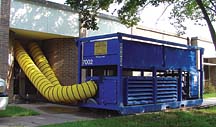As a building owner, being prepared means having a contingency plan ready to implement in case things go wrong. For example, what would happen if a building's heating, ventilation, or air conditioning system were to break down for an extended period of time? In an office building, it would mean that tenants might have to leave due to uncomfortable temperatures. But in critical applications, such as computer rooms, laboratories, or health care facilities, it could be hazardous to be without part or all of the HVAC system.
Ideally, building owners who have taken the time to create a contingency plan would know exactly what to do in case of system failure. The plan would enable a quick and seamless response for system failures, resulting in little or no disruption to tenants or critical applications.
Plan Benefits
Things can happen that are out of our control, and it's almost impossible for building owners to prepare for every worst-case scenario. But building owners/operators can prepare for the basic disruptions, such as mechanical system failures, acts of nature, etc. The more work prepared in advance, the more likely an emergency plan will help save time and money.A plan can help facilitate the quick and seamless response of all parties involved and enable building owners and managers to make decisions quickly in a potentially difficult situation. Having a plan already in place can also help with any liability issues resulting from injury, occupant health, or equipment/computer malfunction.
"We often work with building owners/operators to devise contingency plans so that everyone involved has a better understanding of their critical HVAC and power systems," said Nick Sickmen, marketing manager, HVAC Portable Systems Inc./Carrier Corp., Houston.
Abbreviated to HPSI, the company specializes in rental temperature control and electrical power equipment and provides temporary equipment including chillers, air conditioners, air handlers, cooling towers, boilers, heaters, dehumidifiers, and generators.
"In some cases, we have prearranged pricing [for portable equipment] because in the event of an emergency, the last thing the building owner/operator has time to do is find multiple vendors and try to sort through pricing quotes, etc.," said Sickmen.
Contractors should get involved with devising contingency plans for their commercial customers, he said, because in many cases, contractors know more about the facility than the owner/operator.
"Contractors are an enormous asset for the building owner and HPSI," stated Sickmen. "They understand temporary system tie-ins, electrical disconnects and the general state of the equipment. Having them involved with the plan will help facilitate an effective response."

Devising A Plan
When devising a contingency plan with building owners, Sickmen said his company identifies several steps to go through in order to identify major issues. The first step in developing an emergency response plan is to identify the facility's critical equipment."Begin this analysis by assuming the worse-case scenario - the HVAC system breaks down on the hottest day of the year," said Sickmen. "Any systems or equipment that are considered revenue producers or that have lives depending on them should be considered critical equipment."
The next step is to create a list detailing the portable equipment that would be required to replace the functions of the critical equipment identified. HPSI notes that the list should take into consideration the size of the space, the configuration of existing equipment, and other building-specific information, such as the water pressure and the type of structure.
The equipment list should also include any necessary accessories, including the water hoses, pumps, valves, fittings, and flexible ducts.
Along with the equipment list, a complete, detailed equipment layout with drawings and photographs should be developed to help facilitate quick installation and to make sure the necessary space is available and in the least obtrusive area.
A list of in-house emergency contacts and phone numbers should also be developed. The list should include building owners and managers, maintenance personnel, and anyone else who may be affected by a system breakdown.
After the equipment layout has been developed, it is necessary to provide the piping and duct connections and electrical disconnects needed for temporary equipment installation. Making changes before an emergency, such as adding access valves in large pipes, can save time and money.
"Many facilities were not designed with a temporary system in mind, and there may be obstacles such as space limitations for the equipment, the structure itself, water pressure, piping, duct connections, electrical disconnects, enough ‘house' power to run the system, and many more," noted Sickmen.
He pointed out that the benefits of creating a contingency plan can be readily found in the story of a 42-story office building that experienced a motor failure on one of its 1,200-ton chillers. Preliminary estimates concluded that the system would be down for six to eight weeks.
"Based on an earlier contingency plan with HPSI, access valves and piping had been added for a temporary system," said Sickmen. "The weather was still cool and HPSI designed a 500-ton water-cooled system that would later be expanded to 1,000 tons due to increasing hot weather."
The contingency plan helped the building owners recognize the obstacles that needed to be addressed for sizing and design of the system. Obstacles such as the building's tight spaces and 300-psig water pressure limited the type of equipment that could be used.
When properly prepared, a contingency plan can help building owners prepare for future events, saving them time, while reducing the expense and aggravation of an emergency situation.
Publication date: 02/09/2004


Report Abusive Comment